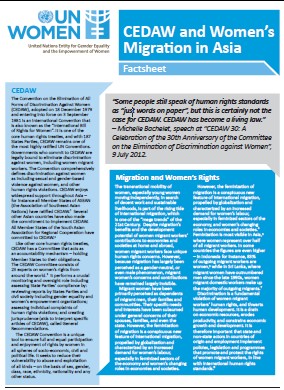
Factsheet: CEDAW and Women's Migration in Asia

The Convention on the Elimination of All Forms of Discrimination Against Women (CEDAW), adopted on 18 December 1979 and entering into force on 3 September 1981 is an international Convention that is also known as the “International Bill of Rights for Women”. It is one of the core human rights treaties, and with 187 States Parties, CEDAW remains one of the most highly ratified UN Conventions. Governments who commit to CEDAW are legally bound to eliminate discrimination against women, including women migrant workers. The Convention comprehensively defines discrimination against women as including sexual and gender-based violence against women, and other human rights violations. CEDAW enjoys widespread support throughout Asia – for instance all Member States of ASEAN (the Association of Southeast Asian Nations) have ratified CEDAW. Several other Asian countries have also made the commitment to implement CEDAW. All Member States of the South Asian Association for Regional Cooperation have committed to CEDAW.
Like other core human rights treaties, CEDAW has a Committee that acts as an accountability mechanism – holding Member States to their obligations. The CEDAW Committee consists of 23 experts on women’s rights from around the world.3 It performs a crucial monitoring and oversight role including assessing State Parties’ compliance by: reviewing reports by States Parties and civil society including gender equality and women’s empowerment organizations; assessing individual complaints of human rights violations; and creating jurisprudence (aids to interpret specific articles of CEDAW), called General Recommendations.
The CEDAW Convention is a unique tool to ensure full and equal participation and enjoyment of rights by women in all spheres of socio-economic, civil and political life. It seeks to reduce their vulnerability to abuse and exploitation of all kinds – on the basis of sex, gender, class, race, ethnicity, nationality and any other status.